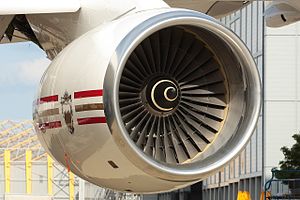Rolls-Royce RB211
| RB211 | |
|---|---|
 |
|
| Rolls Royce RB211-524C2 engine on a Bahrain Air Boeing 747SP | |
| Type | Turbofan |
| National origin | United Kingdom |
| Manufacturer | Rolls-Royce |
| First run | 1969 |
| Major applications |
Lockheed L-1011 TriStar Boeing 747 Boeing 757 Boeing 767 Tupolev Tu-204 |
| Developed into | Rolls-Royce Trent |
The Rolls-Royce RB211 is a British family of high-bypass turbofan engines made by Rolls-Royce plc and capable of generating 37,400 to 60,600 pounds-force (166 to 270 kilonewtons) thrust.
Originally developed for the Lockheed L-1011 TriStar, it entered service in 1972 and was the only engine to power this type of aircraft. Its RB211 engine was the first three-spool engine, and it was to turn Rolls-Royce from a significant player in the aero-engine industry into a global leader. Already in the early 1970s the engine was reckoned by the company to be capable of at least 50 years of continuous development.
The RB211 was officially superseded in the 1990s by the Rolls-Royce Trent family of engines, the conceptual offspring of the RB211.
In 1966 American Airlines announced a requirement for a new short-medium range airliner with a focus on low-cost per-seat operations. While it was looking for a twin-engined plane, the aircraft manufacturers needed more than one customer to justify developing a new airliner. Eastern Airlines was also interested, but required greater range and needed to operate long routes over water; at the time, this demanded three engines in order to provide redundancy. Other airlines also favored three engines. Lockheed and Douglas responded with designs, the L-1011 TriStar and DC-10 respectively. Both had three engines, transcontinental range and seated around 300 passengers in a widebody layout with two aisles.
Both planes also required new engines. Engines were undergoing a period of rapid advance due to the introduction of the high bypass concept, which provided for greater thrust, improved fuel economy and less noise than the earlier low-bypass designs. Rolls-Royce had been working on an engine of the required 45,000 lbf (200 kN) thrust class for an abortive attempt to introduce an updated Hawker Siddeley Trident as the RB178. This work was later developed for the 47,500 lbf (211 kN) thrust RB207 to be used on the Airbus A300, before it was cancelled in favour of the RB211 programme.
...
Wikipedia
